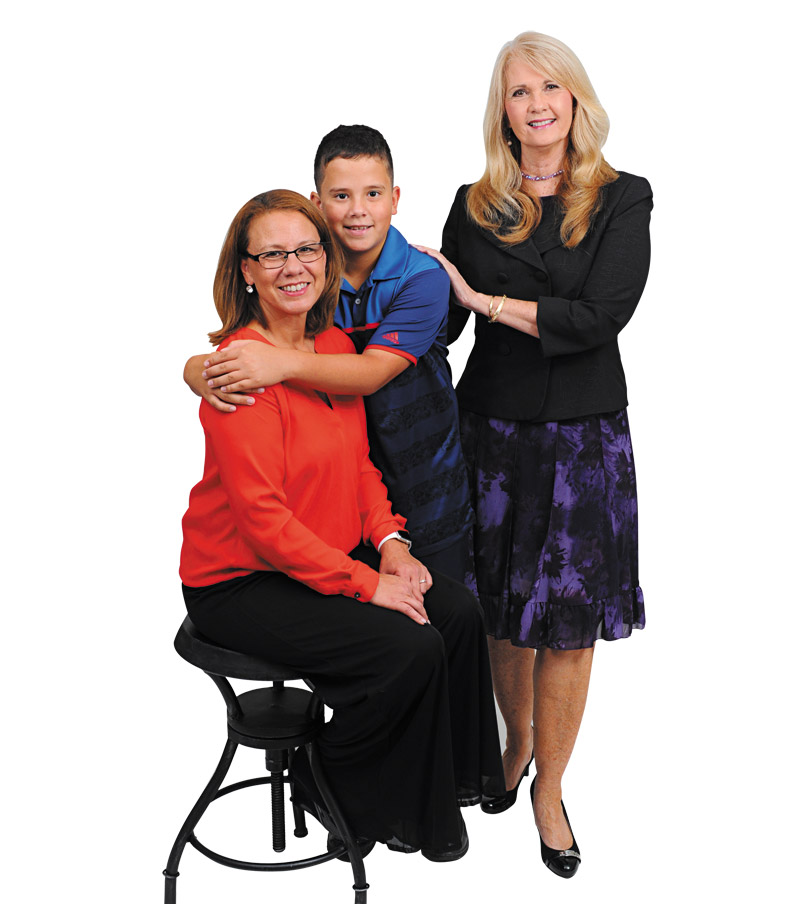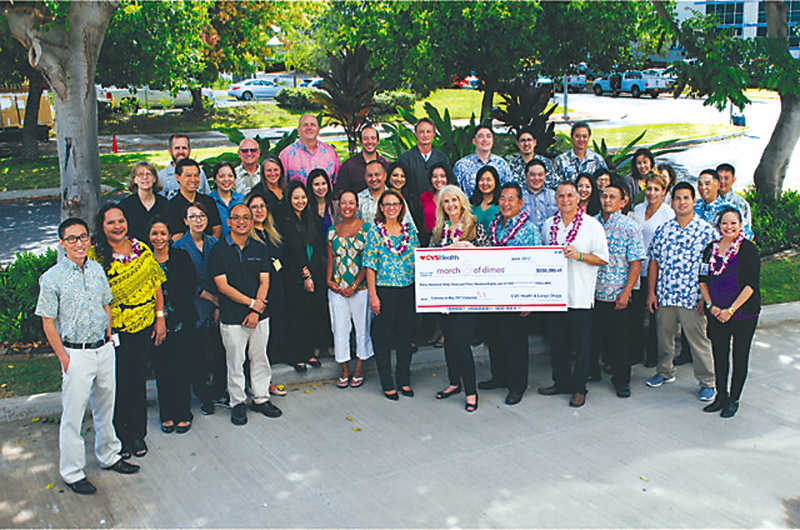The March Goes On

(From left) Tanya Demattia, regional manager of Longs Drugs/CVS Health Hawai‘i, and her son, Braylon, with Carmella Hernandez, executive director of March of Dimes Hawai‘i
If March of Dimes has taught us anything during the foundation’s lengthy history, it’s that the job is never over.
Consider the nonprofit organization’s original mission: finding a cure for polio. That job was completed nearly six decades ago when two American medical researchers, Drs. Jonas Salk and Albert Sabin, successfully tested vaccines against the muscle-debilitating disease. Prior to that, thousands of U.S. citizens — mostly children — were severely affected by the virus poliomyelitis, and treatments often required patients to be quarantined and placed in tank respirators known as the “iron lung,” to help them breathe.
But even after the polio epidemic ended, the organization’s many scientists and volunteers refused to congratulate each other on a job well done, close shop and ride off into the sunset. Instead, they opted to change course, find some other way to reach out and assist children and their families.
In subsequent years, the foundation began taking aim at the physical and mental disorders that occur in children before birth; eventually, its members’ battle cry became “a fighting chance for every baby.” Or as Carmella Hernandez, executive director for March of Dimes Hawai‘i, says, “Our mission today is to improve the health of babies by preventing birth defects, premature birth and infant mortality.”

Earlier this year, Longs Drugs/CVS Health Hawai‘i representatives presented a donation check to March of Dimes Hawai‘i. Through the combined efforts of the retail pharmacy/health care company and its 3,000-plus employees, $330,380.41 was raised for the nonprofit organization and its ongoing efforts to prevent birth defects and premature birth. PHOTO COURTESY LONGS DRUGS/CVS HEALTH HAWAI‘I
Locally, the fight continues for newborns. According to March of Dimes Hawai‘i, one in every 10 babies is born premature and is thus more likely to deal with a lifetime of health issues. And with the astronomical costs associated with neonatal care, money (lots of it) is needed to fund programs that help infants and their families, as well as subsidize the necessary research that delves into the causes, treatments and preventative measures for premature birth and birth defects.
This year’s March of Dimes Governors’ Ball — which is scheduled for Nov. 4 at the Sheraton Waikīkī Hawai‘i Ballroom — is one of two annual opportunities for the Hawai‘i chapter to raise money for its all-important mission. (The other fundraiser is March for Babies, which is held in April.) From 5:30 to 10:30 p.m., guests will be treated to a silent and live auction, entertainment and delicious fare.
But as always, the highlight of the evening will be the presentation of the 2017 Franklin Delano Roosevelt Award for Distinguished Community Service.
“Every year, our nominating committee gets together to discuss the people, organizations and businesses that have been really supportive of our community and have distinguished themselves for their work with the March of Dimes,” says Hernandez.
“This year, we’ve selected Longs Drugs/CVS Health Hawai‘i.”
Rebirth Of The Ball
To better understand how the Governors’ Ball came to be, one must turn back the clock to a previous era, when another shindig was seemingly ubiquitous in America.
The time was 1938, and President Franklin D. Roosevelt — who was diagnosed with polio at age 39 and, as a result, would spend the remainder of his life partially paralyzed — had just launched the pre-March of Dimes organization called the National Foundation for Infantile Paralysis, as well as a fundraising event named The President’s Birthday Ball.
“When Roosevelt was president, he used to hold a ball every year on his birthday to raise money to fight polio,” Hernandez explains. “During that time, he’d encourage governors and business leaders from across the country to do the same thing in their own communities. Even our own territorial governors were holding these birthday balls to help with the fundraising efforts.”
Soon, money began pouring in from concerned citizens. Entertainer Eddie Cantor (who would later “coin” the foundation’s unique name) then raised the stakes on his popular national radio show by challenging listeners to send dimes to President Roosevelt to help with the cause. Weeks after the request was issued, more than 2.6 million dimes arrived in envelopes at the White House.
The birthday balls remained the major money-maker in the fight to eradicate polio, and between 1938 and 1955, an estimated 6,000 of these parties were staged annually across the country. Of course, once the cure for polio was found, the balls were history.
Or so it seemed.
In the mid-’90s, members of the Hawai‘i chapter met with then-Gov. Ben Cayetano, who agreed with their recommendation to revive the old ball locally and christen it with a new name — one that honored the previous efforts of Hawai‘i’s territorial governors. The inaugural Governors’ Ball was
officially launched in 1996, and since then, a number of recognizable individuals and companies have claimed the coveted community service award, including the Sullivan Family of Companies (2013); Ray Vara, president and CEO of Hawai‘i Pacific Health (2016); Dennis Francis, president and publisher of Honolulu Star-Advertiser (2012); Stanford Carr, developer (2010); and Danny Kaleikini (2009) and Carole Kai (2015), entertainers.
You’ve Come
A ‘Longs’ Way
This year’s awardee, Longs Drugs/CVS Health Hawai‘i, has been an integral part of the March of Dimes Hawai‘i ‘ohana since 2008.
“We’re grateful to receive this amazing recognition from the March of Dimes,” says Tanya Demattia, regional manager of Longs Drugs/ CVS Health Hawai‘i, who’s scheduled to accept the community service award, along with the company’s area vice president Joe Awais and senior vice president Hank Casillas, at the Nov. 4 event.
“For years, Longs has supported the incredible work that the March of Dimes does to help the tiniest of patients survive and thrive. Our employees love supporting their local March of Dimes walks, and over the last five years alone, we’ve raised more than $870,000 through in-store campaigns, through the merchandise we sell like the March of Dimes Teddy Bears, and through our employees holding bake sales and potlucks and donating their own money to the March of Dimes.”
Last spring, the company’s 3,000-plus employees raised more than $330,000 for the foundation — a staggering amount that caused Hernandez to “almost fall off my seat when I saw the numbers.” And in the past nine years, the drugstore chain has been responsible for drumming up more than $1.5 million in donations.
“They really knock it out of the park for us,” says Hernandez about the prodigious fundraising abilities of the retail pharmacy and health care company. “But then again, they always push us over the top when it comes to helping us reach our goals. In fact, their efforts account for about a quarter of our annual budget.
“What has been so exciting about Longs’ participation is that their employees all get behind it 100 percent,” she continues. “They come out to our events like I’ve never seen before. They’re enthusiastic and amazing, and their efforts continue to grow and grow each year.”
Such enthusiasm stems from the foundation’s work, which hits close to home for many Longs/CVS employees. This includes Demattia, a native of Detroit, Michigan, who moved with her family to the islands four years ago.
“My own son, Braylon, was born nine weeks early, weighed just 4.4 pounds at birth, and spent four weeks in the NICU in Detroit,” Demattia says. “Whenever I share my own story with our employees and why it’s been important for me to be a part of the March of Dimes, that’s when I’ll often hear their stories and how the March of Dimes has impacted their own lives.”
Today, Braylon is a healthy 11-year-old boy who’s quite active in sports. He’s also growing by leaps and bounds. “Oh, he loves playing roller hockey, baseball and golf,” admits his proud mother. “And he’s almost as tall as me!”
Forward, March!
Important tests and analyses continue to be conducted at the foundation’s five prematurity research centers around the country.
Recently, one of the centers experienced a significant breakthrough regarding preterm births, as scientists were able to identify six gene regions in pregnant women they believe play a significant role in determining the length of pregnancies and the timing of delivery. Hernandez says the unearthing of this genetic information is exciting because “preterm birth has been such a difficult health problem to solve.”
“This discovery is a launching platform for deeper research, some of which has already begun,” she explains. “In the future are potential diagnostic tests, new medications, improved dietary supplements or other changes that could prevent women from going into preterm labor and save more babies from death or disability.”
Which is why it’s important to support events such as the annual Governors’ Ball and March for Babies, she adds, because while the March of Dimes’ job is seemingly never over, the hope is that someday — through continued funding and research — it just may be.
“I’ve always said that just as we found a cure for polio, I hope that one day we’ll be able to find the cure for birth defects and premature births,” Hernandez opines wishfully. “That way, we’ll finally be able to put ourselves out of business.”






